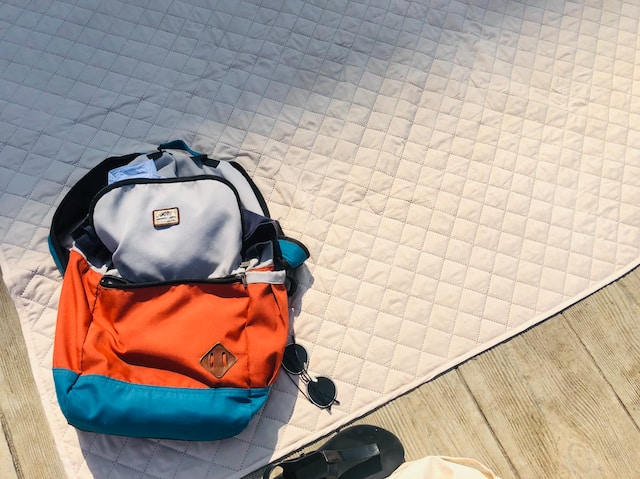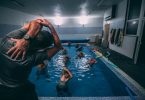Are you new to water polo and wondering what you should bring to practice? It’s crucial to have the appropriate gear and equipment, regardless of whether you’re a novice or a seasoned player. Proper preparation will help you focus on improving your skills and having fun in the pool.
First and foremost, you’ll need a swimsuit that is suitable for water polo. According to SwimOutlet.com, “water polo suits are designed to be more durable than regular swimsuits, with extra stitching and reinforced seams to withstand the physical demands of the sport.” Additionally, you’ll want to bring a pair of goggles to protect your eyes from splashing water and help you see clearly.
Apart from the water polo gear, it’s important to bring a towel, sunscreen, and water bottle to the practice. It’s also advisable to carry a change of clothes for dryland training, such as athletic shorts and a t-shirt.
By packing these items in your swim bag, you’ll be ready to tackle any water polo practice with confidence.
Essential Items
Swimwear
When it comes to water polo, the right swimwear is essential. Men typically wear swim briefs, also known as speedos, while women can choose between a one-piece swimsuit or a two-piece bikini.
It’s important to choose a swimsuit that fits snugly and allows for freedom of movement. Loose-fitting swimwear can hinder your performance in the water.
Goggles
Goggles are another essential item for water polo practice. They protect your eyes from the chlorine in the pool and help you see clearly underwater.
Look for goggles with a comfortable fit and adjustable straps. Some goggles are designed specifically for water polo with a low profile to minimize drag.
Swim Cap
A swim cap is not always required for water polo practice, but it can help keep your hair out of your face and reduce drag in the water. Silicone caps are more durable and comfortable than latex caps, but both options are available. Choose a cap that fits snugly but is not too tight.
Towel
A towel is a must-have item for any water polo practice. Use it to dry off after getting out of the pool or to wipe your face during breaks. A microfiber towel is a good option because it dries quickly and takes up less space in your bag.
Water Polo Equipment
When heading to water polo practice, it’s important to make sure you have all the necessary equipment. Here are the key items you should bring:
Water Polo Ball
The water polo ball is one of the most important pieces of equipment you’ll need. It’s a unique ball that is smaller and harder than a regular basketball or soccer ball.
This ball is designed to be used in water and is made of a waterproof material that makes it easier to grip. Make sure you bring a ball that meets the official size and weight requirements for your league.
Water Polo Caps
Water polo caps are another essential item you’ll need. These caps are made of a durable material and come in different colors to distinguish between teams.
They also have ear protectors built into them to help prevent ear injuries. Make sure you bring two caps, one for each team, and wear them properly to protect your head and ears.
Mouthguard
A mouthguard is a crucial piece of equipment that can help protect your teeth and jaw from injury. Many water polo leagues require players to wear a mouthguard, and it’s a good idea to wear one even if it’s not mandatory. Make sure you choose a mouthguard that fits properly and is comfortable to wear.
Ear Plugs
Ear plugs are another important piece of equipment that can help prevent ear injuries. Water polo involves a lot of splashing and contact with other players, which can cause water to get into your ears.
Ear plugs can help keep water out and reduce the risk of ear infections and other problems. Make sure you choose ear plugs that fit properly and are designed for use in water.
By bringing these essential pieces of equipment to water polo practice, you’ll be ready to play your best and stay safe in the pool.
Hydration and Nutrition
Proper hydration and nutrition are crucial for peak performance during water polo practice. Here are some tips to help you stay hydrated and fueled:
Water Bottle
Make sure to bring a water bottle to practice and drink water regularly throughout the session. Dehydration can lead to decreased performance and even injury. Water Polo Strong recommends drinking approximately half your body weight in ounces of water per day.
During practice, take frequent water breaks and sip water during rest periods.
Snacks
It’s important to fuel your body with the right nutrients before and after practice. According to SwimOutlet.com, eat a light meal or snack one to two hours before practice.
Choose something that is easy on your stomach, but still substantial. Good options include a banana with peanut butter, yogurt with granola, or a protein bar. After practice, make sure to refuel with a snack that includes protein and carbohydrates, such as a turkey sandwich or a smoothie with fruit and Greek yogurt.
Here are some other snack ideas:
- Trail mix with nuts and dried fruit
- Apple slices with almond butter
- Celery sticks with hummus
- Hard-boiled eggs
- Whole grain crackers with cheese
Remember, proper hydration and nutrition are key to performing at your best during water polo practice. Make sure to bring a water bottle and pack some healthy snacks to keep you fueled and energized throughout the session.
Optional Items
While the essential items are the bare minimum you need for water polo practice, there are a few optional items that you can bring to make your experience more comfortable and convenient. Here are some items you might want to consider bringing:
Sunscreen
Water polo practice often takes place outdoors, and if you’re practicing in the middle of the day, the sun can be intense. Protect your skin by applying sunscreen before practice, and consider bringing a small bottle of sunscreen with you to reapply during breaks. Look for a sunscreen that’s water-resistant and has a high SPF, such as SPF 30 or higher.
Extra Clothes
After a long practice, you might want to change out of your wet clothes and into something dry. Consider bringing a change of clothes, including a dry shirt, shorts, and underwear. You might also want to bring a towel to dry off with after practice.
Flip-Flops
Walking around barefoot on wet pool decks can be uncomfortable and even dangerous. Consider bringing a pair of flip-flops or sandals to wear before and after practice. Make sure they have a non-slip sole to prevent slipping on wet surfaces.







